When Albert Hofmann took his famous bicycle ride in 1943, the last thing on his mind must have been a dwarf on a merry-go-round or Peter Fonda in a red V-neck sweater. All these things, and more, can be found in Corman’s psychedelic tribute to the properties of Lysergic acid diethylamide. The drug has been used in a variety of ways: pain relief, an anti-psychotic, a treatment for alcoholism. Corman, perhaps wisely, restricts himself to the entheogenic properties, however, and treats the viewer to far-out visual effects and Dennis Hopper.
Great jumper, kid. How do you like this beard?
The pre-Easy Rider triumvirate of writer Jack Nicholson and actors Fonda and Hopper basically give us a 90 minute acid trip of a film. The niceties of the plot are dispensed with rapidly, and Bruce Dern, in a funky turtle neck jumper/beard combination acts as a guide during Fonda’s first trip. Before the first pills are popped, unfortunately, the film’s weakness becomes apparent. Despite, apparently, being made in conjunction with the input of psychedelic aficionados, the goings on are too mannered. The hippy den where Fonda trips is immaculate, complete with nicely painted banisters and appropriate groovy artwork on the walls. It all seems like a Readers Digest guide to mind-altering substances.
This is the funkiest hairdressers I’ve ever been to.
Fonda’s trip starts as a Lucifer Rising outtake, complete with bra-less chicks and a white shirt/trousers-huge medallion outfit. Our hero is soon gettin’ freaky with a nekkid lady, under a Grateful Dead light show. A copy of Allen Ginsberg’s Howl and Other Poems is embarrassingly featured in several shots, as is a brief glimpse of Timothy Leary, seemingly there to boost the film’s authenticity. Corman always seemed a fairly conservative filmmaker, and his distance from the counterculture is horribly apparent.
His skill as a director is also as apparent. The strongest sequence in the film is a superbly edited stroll through a neon-lit street. The rapid cutting and frenetic soundtrack capture a mood that oozed through the truly drug-addled films such as Head and 200 Motels. Rather than keep up the pace, however, this sequence is followed by a stilted scene set in a launderette, with Fonda fascinated by a tumble drier. While it’s possibly realistic, it’s also tedious.

What? I’m going to star in Texas Chainsaw Massacre 2? Enough of the drugs, already.
Fonda was, reportedly, no stranger to drugs at the time, and his performance is full of tension and an authentic-looking 1000-yard stare. Hopper looks even more frazzled than he did in Apocalypse Now, and one assumes that there was very little acting going on. Susan Strasberg is disgracefully sexy as Fonda’s estranged wife. To be honest, though, no one is going to watch this for the acting. It’s the epilepsy-inducing light shows, the topless dancers, the (pretty good actually) soundtrack and the dwarf on a merry-go-round.
 Corman
Corman has a few mild digs at the Establishment, and the whole trip is shown as a fairly balanced experience. To save a lot of ennui, fast forwards to around one hour and three minutes, to the scene with
Fonda running through the streets. Watch that on a loop for an hour or so, to fully understand the power of hallucinogens, and just say no to the chameleons catching flies and the sight of
Fonda chatting up a nightie-wearing preteen girl. -
www.videotapeswapshop.co.uk/
MGM has released a boxed set consisting of 8 previously available Roger Corman titles. The films are packaged as four double feature discs with a film on each side. These titles represent a wide array of subject matters and illustrate how prolific the B movie king is as a moviemaker. Mention Corman's name to most movie fans and they'll likely conure up images of his wildly successful screen adapations of Edgar Allan Poe tales that generally starred Vincent Price. However, there is far more diversity to Corman's achievements, as illustrated by this boxed set. In fact, there is nary a single Price/Corman collaborative effort offered here. I confess to not having seen a number of the films offered in this set and most of those I did see were back during their original releases. Thus, I was able to take a fresh and objective approach to evaluating their worth. For the most part, this eclectic collection offers some of Corman's most impressive (and occasionally underrated) efforts.
Here's a breakdown of each individual title:
- The Wild Angels (1967)- One of Corman's monster hits, I had not experienced the film since I saw it as a 9 year old kid during it's original run. The movie is bascially a wafer-thin story patched together by images that were considered to be outrageously shocking in 1967, and indeed still retain a certain power today. The plot nominally involves the outlaw motorcycle gang abducting a wounded comrade from a local hospital - a plan that goes awry and leads to a funeral service that becomes an orgy of rape and destruction. Corman doesn't sugar-coat the gang lifestyle. The self-centeredness, lack of intellect and abscence of loyalty among the members is presented in a forthright manner. The person who is your friend one minute, mocks your tragic circumstances the next. Women are passed around like beer bottles to be used at will by the barbaric male members of the gang. Corman's emphasis on making the gang appear realistic also leads to an inevitable problem: there are no heroes in the film. In fact, there isn't a soul with a single redeemable attribute. Whether Corman sought to make these characters sympathetic seems doubtful. Rather, he seems to have simply been utlizing the Corman touch for exploiting a subject matter in a timely way. The film is primarily interesting because of its cast. Peter Fonda went from being a drab second-rate actor to a pop culture icon with this film and posters of him astride his chopper still adorn head shops today. Nancy Sinatra is largely wasted in a underdeveloped role that could have been played by any actress. Yet, Corman well knew the exploitation value of casting this popular singer. The supporting characters include Corman favorite Bruce Dern and his (then) real life wife Diane Ladd and in minor roles Michael J. Pollard and Gayle Hunnicutt. Members of the actual Hell's Angel's Venice, California chapter also appeared as bikers.Interestingly, Peter Bogdanovich worked on the film in several capacities without screen credit. The film boasts a hallmark of many Corman productions: stunning cinematography that belies the relatively low budget. The film remains a distasteful experience largely because the scum bums depicted onscreen don't confine their assaults to law enforcement officers. They gang rape a grieving widow from their own group- at the same funeral service in which they relentlessly beat and humiliate a preacher. A nurse who tries to care for a wounded gang member is sexually assaulted and the group sports Nazi flags on everything from clothing to caskets. The script attempts to give the characters some motivation for their actions, but it sounds like the ill-conceived hodgepodge that it is - unless you feel that not wanting to be hassled by "the man" is justification for these acts. The film was a huge success at the box-office and inspired a short-lived flood of even cruder biker movies. It would be interesting to see a special edition of the movie with Corman's comments to see if he has any regrets about the film today.

- The Trip (1967)- The story behind the making of this controversial movie, made at the peak of the flower power movement, is more bizarre than anything that appears on screen- and that's saying something. It's a slight story about a director of TV commercials (Peter Fonda) who decides to experiment with LSD by taking a "trip" under the supervision of a counter-culture doctor (Bruce Dern, refreshingly cast for once as the "normal" character in a film otherwise populated by weirdos.) The script was written for Roger Corman by none other than Jack Nicholson - yes, that Jack Nicholson, who was still struggling to make a name for himself. (Only a year previously he had appeared on an episode of The Andy Griffith Show!) Corman decided the only way to convey the experience of an LSD trip onscreen was to take the plunge himself. Not being a hippie or a radical, his friends considered it the supreme irony that the relatively conservative director was about to go all the way in the name of research. Corman later said that while his experience was a very positive one, it was so esoteric that he could never capture it on film. That didn't stop him from trying. The Trip is largely a visual experience that is very much a period piece. The psychedelic effects were groundbreaking at the time and still impress today. However, the nude scenes have lost their shock value over time and the film eventually becomes tedious because there are no compelling plot devices. We just watch Fonda run the myriad of experiences from ecstatic joy to horrendous fright as his trip brings him to the edge of reality. The film would have been more powerful if Dern had the leading role.
Peter Fonda has emerged as a wonderfully talented character actor over the decades, but in these early days as a star he had very little screen presence. The movie also features Susan Strasberg and Salli Sachse but both actresses are basically just used for their physical attributes in the sex scenes. Curiously, Dennis Hopper also has a supporting role, meaning that this film was actually the initial teaming of Fonda, Hopper and Nicholson - two years prior to Easy Rider. The film is only worth the trip, so to speak, if you are prepared to view it as a mini time capsule of a long gone era.
- Bloody Mama (1970) - I had consciously avoided this movie over the decades thinking it would be an embarrassing spoof of Bonnie and Clyde. I was pleasantly surprised to discover its many values, not the least of which is an eclectic cast that boasts Shelly Winters, Robert DeNiro, Don Stroud, Bruce Dern, Pat Hingle, Diane Varsi and even Scatman Crothers. The movie is nominally the tale of the bizarre Barker gang that consisted of matronly Ma Barker and her bloodthirsty sons. I have no idea if any attempt was made to base the story on historical fact but it's a thoroughly engrossing movie from start to finish. Despite the campy ad campaign ("The Family That Slays Together, Stays Together!"), this is not primarily a spoof. The film has moments of broad comedy but its also steeped in pathos.
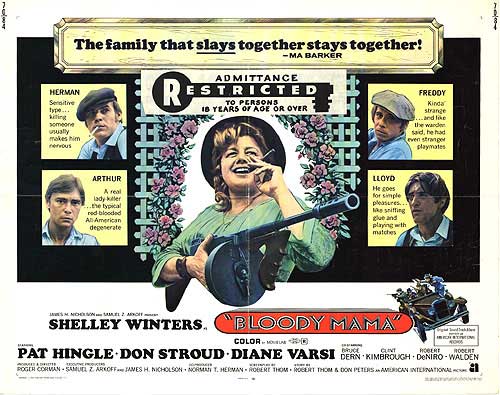
The centerpiece of all the action is Shelly Winters. In the early 1950s, Winters was being groomed as a blonde bombshell in the Marilyn Monroe mode. A decade later, she found that as her waistline expanded, so did her popularity. By then, she was primarily cast as in generic fashion as a frumpy, overweight floozy from the other side of the tracks. Her penchant was for chewing the scenery (and apparently anything else within arm's reach!). In the role of Ma Barker, however, Winters gets to showcase a full range of talent that was often denied her in other parts. To put it in medical lingo, she is one screwed up chick. Ma is the doting matriarch of the family who pulls up stakes, leaves her wimpy husband behind and hits the road for a life of crime with her "boys". The latter consist of dopey hillbillies who make the rednecks from Deliverance
look like members of Phi Beta Kappa. Along the way, Ma is alternately nurturing and murderous. She shamelessly beds her own sons and even tries to seduce a hostage. The film goes for broad laughs but alternates with dramatic scenes that are quite shocking. (The murder of an innocent teenage girl is almost too unbearable to watch.). Corman's direction is top notch as are all of the performances. Special kudos to the production design team. This looks like an expensive film and Corman gets all the details right in conveying the period of the Great Depression. The movie ends in a wild shootout that is suberbly staged and directed. Give this one a try - and by all means make sure you invite mom to share the experience with you.
- A Bucket of Blood (1959)- One of Corman's least-heralded productions, this epitomizes the bare-bones style of filmmaking that became his trademark in his early career. With the exception of the climax, there aren't even any exteriors in the film and one begins to suspect they are watching a filmed stage play. Character actor Dick Miller stars as Walter Paisley, a nerdy, virginal bus boy in a coffee shop frequented by beat poets and artists. Walter suffers the slings and arrows of this crowd every night, yet he still aspires to be an artist himself - despite the fact that these people are so pretentious they probably consider Allen Ginsberg's Howl to be a light read for the beach. After Walter accidentally kills his landlord's cat, he covers up the crime by slapping clay over the animal and presenting it as a work of art - complete with a knife sticking out of it's side! In an insightful bit of satire on the part of the script, the artists at the coffee shop immediately proclaim this to be a masterpiece- not knowing that the sculpture conceals the body of an actual cat. You can see where the plot is going immediately as it swerves into House of Wax territory. In order to meet the demand for new masterpieces, Walter graduates to murdering people so their bodies can act as the basis of his latest work of art. The film is actually quite witty and enjoyable and it's low budget black and white production values add to its charm. Miller, one of the few Corman alumni not to achieve stardom after having a leading role, gives a highly enjoyable performance as the lovable nerd who turns into a psychotic murderer just to fit in with the intelligensia.The movie's cynical potshots at pretentious beat poets also hit the mark, but the climax feels rushed and lacks the the sense of irony that such stories virtually demand.
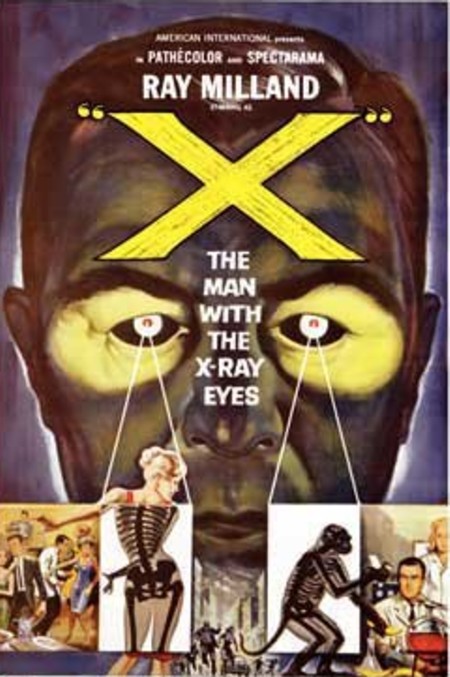
- X: The Man with the X Ray Eyes (1963) - This cumbersomely titled mini classic has developed a cult following in the years since its release. (In fact, the main title sequence shows the movie was originally titled merely X with the subtitle obviously added at the last minute on the promotional materials.) Ray Milland stars a doctor who experiments with a procedure that gives him the ability to see through any type of matter. His intention is to use this gift to assist in medical procedures, but you don't have to be Nostradamus to figure out things will rapidly go awry. Before you can sing the first verse of Can't Take My Eyes Off of You, Milland finds the procedure has unintended side effects. He can now see too much matter and the result threatens to drive him insane. After he accidentally kills a colleague, he goes on the lam - clad "inconspicuously' in oversized black radiation glasses that makes him look like a missing Blues Brother. He attempts to lay low by working in a carnival under the management of sleezy barker Don Rickles, but finds that facing a murder charge is more preferabel than having Don Rickles as a boss. The goofy but engrossing screenplay leads to what promises to be a thrilling conclusion. However, the ending (long debated among the movie's fans) is as abrupt as it is unsatisfying. Still, the film benefits from a strong performance by Milland. The former Oscar winner may have fallen on hard times by this point, but still performs as though he were playing King Lear.
- The Premature Burial (1962)- It's Milland and Corman again for this adaption of Poe's story about a man obsessed with a fear of being buried alive. The film was supposed to have starred Vincent Price but when Corman had a falling out with American International Pictures, which had Price under contract, he sought to release the movie with the Pathe company. After he had cast Ray Milland in the starring role, AIP ironically ended up buying Pathe and released the film after all. We're second to none in our admiration of Vincent Price's work in the Corman Poe adaptations, but certain plot similarities to previous films Price had done in this line might have made it seem like old hat to audiences.
-
Milland, however, brings a fresh and vigorous presence to the proceedings as a man who is locked in a self-imposed prison over what appears to be an irrational fear. As those around him seek to cure him, the plot provides enough mysteries and things that go bump in the night to mitigate the fact that we know from the very beginning that Milland's character will ultimately find himself in precisely the very situation he most abhors. I found this to be one of the most enjoyable of Corman's Poe films not only due to Milland's wonderful performance but also the presence of a strong supporting cast including Hammer horror favorite Hazel Court, Richard Ney, Heather Angel and dear old Alan Napier, still a couple of years away from playing Alfred the butler on the Batman TV series. The film's interiors have the traditional rich Corman production design, but the exteriors are woefully inadequate. To compensate for the fact that virtually all of the outdoor scenes were shot on a tiny stage, the production team funnels endless clouds of "fog" over the set. After a while you feel you're actually sitting behind a bus inside the Holland Tunnel as opposed to traipsing about the moors. Still, that's the only complaint about this strong entry in the Corman/Poe canon.
- Gas-s-s-s! (1971) - Even a man with Roger Corman's enviable skills of exploiting current film trends can hit a pothole on the highway to success and Gas-s-s-s! is the Ishtar of low budget hippie movies. The premise finds a mysterious - er, Gas-s-s-s!- has been accidentally unleashed by the government with the unintended consequence that it immediately kills everyone over age 25. Apparently, the victims were kind enough to walk themselves into crematoriums because there are scarcely any bodies for the newly liberated younger generation to contend with. The "plot" follows the antics of a disparate group of hippies as they travel the American landscape, which is now an endless string of rock concerts, beer parties and orgies. It's a sign of the insensitivity of these early days of the sexual revolution that cheerleaders gangraped by Nazi-like high school footballer players is considered good sport! If Gloria Steinem had seen this film, she would have been burning more than bras. Even as a dated head trip flick, the movie doesn't work satisfactorily on any level. There is one unintentionally funny scene in which one of the hippie chicks complains about how lame music is today and wants to return to the glory days of the 1960s. One can only imagine her response to the era of Snoop Dog and Britney Spears! Corman explored the gimmick of a world dominated by youth far more successfully in Wild in the Streets(1968), which was an undeniable satire but steeped at least in the pretense of a coherent plot and played with with straight faces by the cast members. There's nothing eduring or endearing about this venture except seeing Cindy Williams, Talia Shire, Bud Cort and Ben Vereen in very early roles. Thus, you'd be excused for passing this Gas-s-s-s!
- The Young Racers (1963)- Several years before John Frankenheimer made directed his big budget Cinerama production of Grand Prix, Roger Corman beat him to the punch with this surprisingly good drama set in the world of international auto racing on the Grand Prix circuit. Don't let the bland title deceive you - this is a thoroughly engrossing story centering on two rival race car drivers who alternate between being close friends and bitter enemies. Mark Damon is the younger driver, a man who has been cuckolded by reigning champ William Campbell, a shameless womanizer who has seduced Damon's fiance. Vowing revenge, Damon befriends Campbell with the intention of betraying him - until a genuine friendship forms. Throughout, Campbell is a complete rogue, willing to humilate his wife, brother and friends in his quest for fame and endless sex play with married women. What sets this film apart from other Roger Corman productions is the use of genuine European locales. The movie was actually shot on location for the Grand Prix races in Belgium, France and England and the footage is remarkably blended in with scenes of the key characters. There are no shoddy rear screen projection techniques employed the scenes featuring Damon and Campbell behind the wheel are genuinely thrilling. No one is arguing that The Young Racers is a work of art - but is a completely compelling film and the nicest surprise I found in this Corman boxed set. (For the record, legend has it that Mark Damon's voice was dubbed by an uncredited William Shatner. Don't pity Damon, however. He progressed from being a B movie star to one of the industry's top producers today.)
EXTRAS:Sadly, most of the titles have no extras except for the occasional trailer. The exceptions are
The Trip which boasts a variety of short featurettes that include relatively recent interviews with Roger Corman and Bruce Dern and
The Premature Burial which has a short interview with Corman. -
Lee Pfeiffer
The story of exploitation filmmaker Roger Corman — and the big breaks he gave to some now-major directors and actors — has been told in many books and Hollywood documentaries.
But no one has told the story as well or with as much emotion as director Alex Stapleton in the 2011 documentary “Corman’s World,” which is now available on DVD.
Through the 1950s and 1960s, Corman ground out B-movies designed primarily for young drive-in audiences. The producer-director made hot rod movies, Edgar Allen Poe adaptations and sci-fi thrillers — anything he could serve up cheaply and with the potential for a lurid advertising campaign.
Most of the Corman films are unwatchable now, but he holds an honored place in Hollywood history for giving big early breaks to directors such as Francis Coppola, Martin Scorsese and Jonathan Demme, and actors like Jack Nicholson, Dennis Hopper, Pam Grier and Bruce Dern.
The clips in “Corman’s World” from “Bloody Mama,” “The Trip,” “Wild Angels” and the rest are of the so-bad-they’re good variety, but the documentary gets its real power from the high caliber of the interview subjects who clearly still believe they owe Corman a lot for helping to launch their careers.
Nicholson gives a terrific interview in which he laughs about how quickly and cheaply movies like “The Terror” and “Little Shop of Horrors” were made, but then bursts into tears when he tries to express his gratitude to Corman.
Stapleton supplies us with a truly happy ending when we see Corman and his wife Julie at the Oscars a few years ago where the producer received an honorary award for his contributions to the industry.







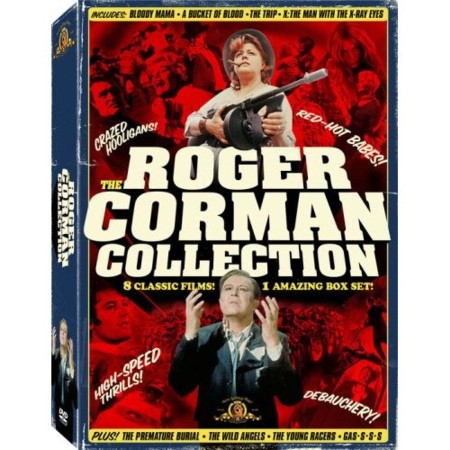
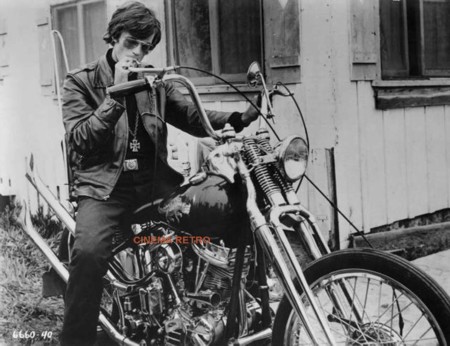

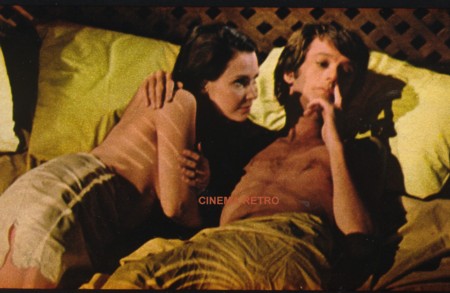


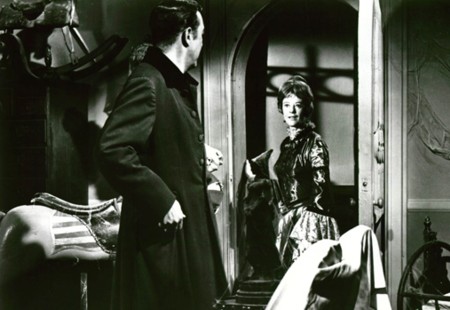
Nema komentara:
Objavi komentar